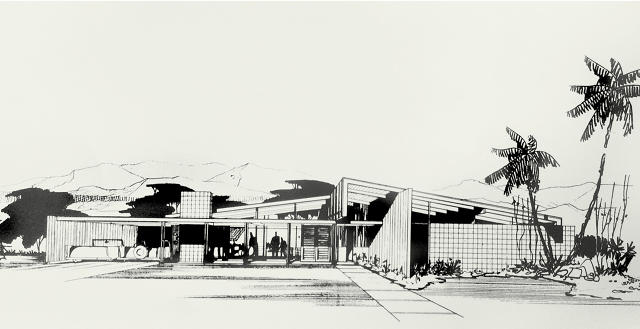A new book on the masterful architect William Krisel documents the golden age of midcentury-modern design.
The midcentury-modern houses of Palm Springs, California, are unmistakable. With their strong geometric lines, post-and-beam construction, open-plan interiors, and floor-to-ceiling windows, they celebrate the dramatic desert landscape and communicate a casual way of living that many of us fantasize about. Just don't call this a "style," proclaims William Krisel, the architect who helped define one of the most iconic design movements of the 20th century—and bring it to the masses.
"Modernism is a philosophy that creates better living through design," he writes in a manifesto that appears in William Krisel's Palm Springs: The Language of Modernism (Gibbs Smith, 2016). It's thanks to this emphasis on how people actually use his homes, as opposed to a dogged obsession over Ivory Tower architectural theory, that earned Krisel popular appeal and has likely fueled present-day interest in his work.

Though Krisel started out designing custom residences with his business partner Dan Palmer, it's tract housing that became his bread and butter—a typology that was long ignored by architects and had a reputation for uninspired monotony. It's estimated that Krisel and Palmer designed more than 40,000 housing units (meaning single-family homes and condos) over the course of their careers. In Palm Springs alone, Krisel and Palmer built more than 1,500 single-family homes, making the city feel like a living museum of their work.
Today, many design fans are scooping up Krisel's homes—ones that sold for $19,000 when they were built fetch over $1 million today. To Krisel, the popularity of midcentury-modern architecture is all because of its roots in philosophy, not aesthetics.

"There is nothing being done in the present architecture world that has the philosophy and beliefs that MCM has," Krisel, who is 92, says via email. "Today's architecture is influenced by 'style' and we all know that style comes and goes. MCM is the same today as it was in the 1950s because it is not a style and is based on solid principles of design and human needs, along with functionalism, respect for the environment, and solving the basic human desires for livability. MCM is capable of enfolding and including new technology and still maintaining the basics of MCM. New energy standards easily fit into MCM. New materials that were not available before also are easily enfolded in MCM. It's a living concept with solid, basic theories all aimed at the human and environmental needs of the day. It will be applicable forever."
The Palm Springs tract houses that Krisel designed celebrate their surroundings, despite being in the harsh desert. Clerestory windows let light shine into the interior rooms and make the roof appear to float over the house. In addition to offering the residents views of the surrounding mountains, they also promoted air circulation. Semi-enclosed patios and swimming pools emphasized indoor-outdoor living and shaded breezeways in some designs helped to lessen the impact of the blazing sun. Although the interiors share similar floor plans, there was opportunity to customize them as an owner desired through the use of flexible room dividers. Lastly, the houses' original finishes and colors (like cactus green, sky blue, and orange) were inspired by the natural landscape.

While many architects are preoccupied with creating a physical signature, midcentury modernists were supposedly more attuned to the inhabitants and users of their designs, according to Krisel. Perhaps some of the present-day nostalgia for what was first developed in the postwar era is a rejection of the obsession with newness.
"There is too much emphasis on being unique with 'look at me' as the driving basis for design without solving the real problem of the human use of a space," Krisel says about the present day architectural profession. "Architects being treated as 'stars' and doing a 'one of a kind' structure appeals to the modus operandi of those practicing architecture today—the total opposite in theory of MCM architecture."
Moral of the story? There could stand to be less ego in contemporary architecture—and perhaps more butterfly roofs.
[All Photos: courtesy Gibbs Smith]